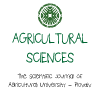Analysis of experimental data
|
Course title: |
Analysis of experimental data |
|
|
Course code: |
AFAED |
|
|
ECTS: |
4 |
|
|
In-class hours |
Lectures: |
15 |
|
Laboratory work/Tutorials: |
15 |
|
|
Self-preparation hours |
Practical training: |
30 |
|
Other: |
30 |
|
|
Total hours: |
90 |
|
|
Language: |
English |
|
|
Study cycle: |
BSc, MSc, PhD |
|
|
Semester: |
Winter & Summer |
|
|
Faculty: |
Faculty of Agronomy |
|
|
Name of the lecturer(s): |
Assoc.Prof. Krasimira Uzunova, PhD |
|
|
Mode of delivery: |
Face-to-face, distance learning or a combination of both |
|
|
Prerequisites: |
Basic knowledge of applied statistics, agrochemistry, soil science, genetics |
|
|
Learning outcomes of the course unit: |
The training in the subject "Analysis of experimental data" for the students of plant protection is related to the basic statistical indicators characterizing the research object (respectively population), the design of the experiment and the meaning of its main elements, errors in the research work and ways of increasing accuracy, working with statistical criteria, and interpreting the results of the analysis. The trainees will be able to enrich their knowledge of working with Excel. Bachelor students will gain knowledge about the basic requirements in carrying out the experimental work, which will be useful and necessary in their further practical and applied activity. |
|
|
Course contents: |
LECTURES 1. Basic requirements and prerequisites for correct betting and deduction of agronomic experiments – replications, variants (unit of observation) 2. Meaning of the main elements in the experience and conditions for obtaining results with the necessary level of accuracy. Design of the experiment – experimental plot (size and shape), repetitions and role of the guards, reporting area 3. Basic statistical indicators of the variation statistics, in the characterization of the studied population. Components of the variation 4. Research errors and accuracy factors. Types of systematic errors. Normal distribution, applying the Student test (t-test) for small and large samples 5. Different ways of comparing the tested variants and their distribution in ranks (groups). Compilation of a table for comparative assessment of the test variants and interpretation of the results. 6. Opportunities to compare tested variants and their distribution in ranks (groups). Apply the GD method - the smallest difference. Interpretation of the experimental data 7. Visiting demonstrative and experimental fields of individual departments of the Agricultural University (or demonstrative experimental sections of the Scientific Institutes around Plovdiv) LABORATORY PRACTICALS 1.Understanding the main statistical indicators - biological / technological interpretation and practical formulas, used in biometric analysis 2. Collection of source material. Basic requirements for composing an average sample. Enter database in Excel spreadsheet 3. Calculation of the main statistical indicators for t-test (with formulas and Excel) 4. Assessing the credibility of the difference between the options examined and compiling a comparative assessment table SEMINARS 1. Practice with the tabular values of the Student Criterion (t) and determine the confidence levels of the difference between the different options/cultivars 2. Practical work on interpretation of real results of diploma theses |
|
|
Recommended or required reading: |
1. Jim Fowler and Lous Cohen,1992. Practical statistics for field biology, John Wiley & Sons Ltd, Chichester, England. 2. Schott R. R., 1990. Foundation mathematics for non-mathematicians, Open university press. 3. Sokal R. and Rohlf J., 1981. Biometry, Freeman and son, New York, 2-nd edn. 4. Trudy Watt, 1993. Introductory statistics for biology students, Chapman & Hall, London |
|
|
Planned learning activities and teaching methods: |
Lectures, tutorial and brainstorming |
|
|
Assessment methods and criteria: |
Assessment of a project |
|
 - Events on the occasion of the 80th anniversary of AU
- Events on the occasion of the 80th anniversary of AU











